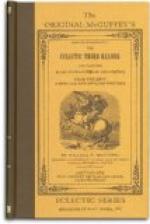6. This fruit is not unlike a cherry, and is very good to eat. Under the pulp of this cherry is found the bean or berry we call coffee, wrapped in a fine, thin skin. The berry is at first very soft, and has a bad taste; but as the cherry ripens the berry grows harder, and the dried-up fruit becomes a shell or pod of a deep brown color.
7. The berry is now solid, and its color is a translucent green. Each shell contains two seeds, rounded on one side and flat on the other. The seeds lie with the flat sides together, and, in one highly prized variety, the two seeds grow together, forming one: this is known as the pea berry. When the fruit is so ripe that it can be shaken from the tree, the husks are separated from the berries, and are used, in Arabia, by the natives, while the berries are sold.
8. The young plants are inserted in holes from twelve to eighteen inches deep, and six or eight feet apart. If left to themselves, they would grow to the height of eighteen or twenty feet; but they are usually dwarfed by pruning, so that the fruit may be easily got at by the gatherer.
9. Thus dwarfed, they extend their branches until they cover the whole space about them. They begin to yield fruit the third year. By the sixth or seventh year they are at full bearing, and continue to bear for twenty years or more.
l0. Before the berry can be used, it undergoes a process of roasting. The amount of aromatic oil brought out in roasting has much to do with the market value of coffee, and it has been found that the longer the raw coffee is kept, the richer it becomes in this peculiar oil, and so the more valuable. But after the coffee is roasted, and especially after it is ground, it loses its aroma rapidly.
11. Arabia produces the celebrated Mocha, or “Mokha,” coffee, which is the finest in the world; but little or none of the best product is ever taken out of that country. The Java coffee from the East Indies is next prized, but the best quality of this kind is also quite difficult to obtain, and many, therefore, prefer the finest grades of Rio coffee from South America to such Mocha and Java as can be had in our country.
Definitions.—l. Af-ford’ed, yielded, produced. 3. Off’spring, descendants, however remote, from, the stock. 4. Pli’a-ble, easily bent. 7. Trans-lu’cent, permitting the passage of light. 8. Prun’-ing, trimming. 10. Ar-o-mat’ic, containing aroma, fragrant.
Exercises.—What country first supplied coffee? How did the plant come to be grown in other countries? Describe the plant. What is said of the fruit? How are the plants cultivated? What is said about the roasting of coffee? What are the three principal kinds of coffee used, and how are they valued?




